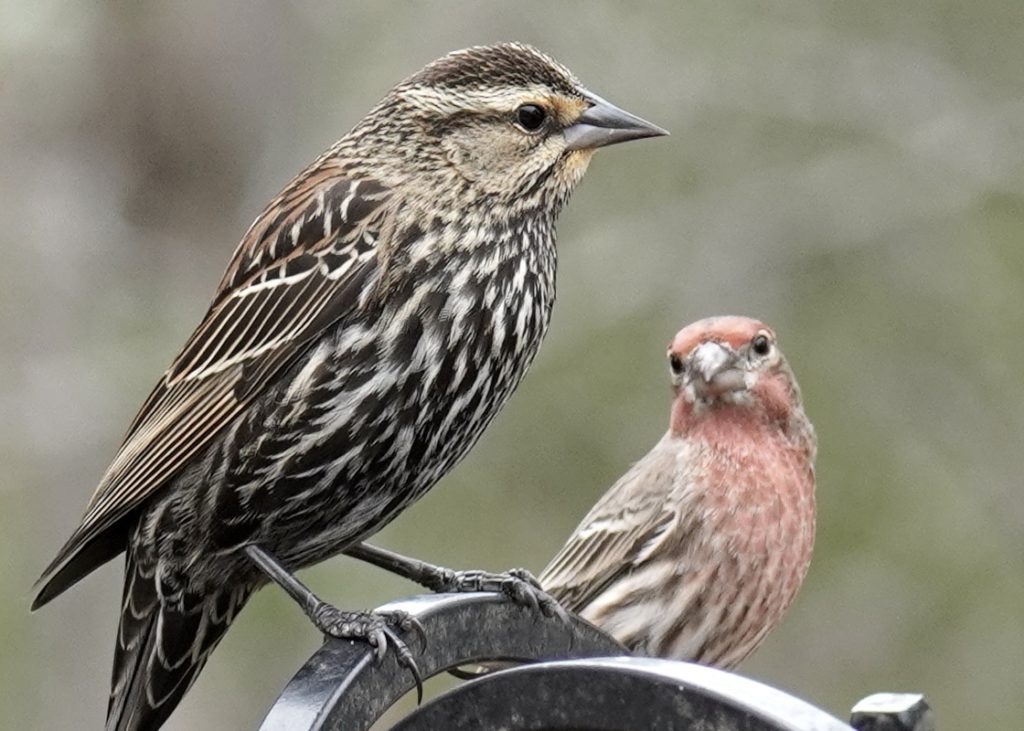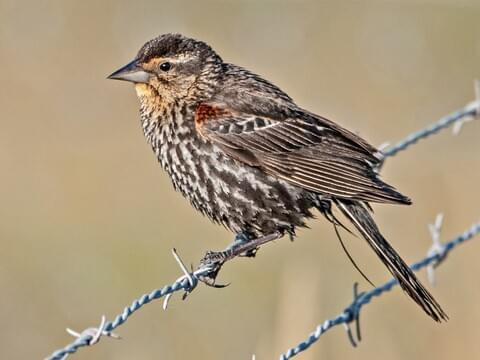Female Red Winged Blackbirds and Sparrows are fascinating birds. Both are small, but have distinct features.
Understanding these differences helps bird enthusiasts and nature lovers. Recognizing the unique traits of each bird can be both fun and educational. Female Red Winged Blackbirds, often overlooked due to their less vibrant colors, have their own charm. Sparrows, common in many areas, are easy to spot and study.
Comparing these two birds will highlight their unique behaviors and habitats. This knowledge can enhance your bird-watching experiences and deepen your appreciation for nature’s diversity. Let’s explore the key differences between Female Red Winged Blackbirds and Sparrows.

Credit: feederwatch.org
Physical Characteristics
Female Red Winged Blackbirds have streaked brown feathers and a yellowish wash on their chest. Sparrows, however, are smaller with a plainer appearance and more compact bodies.
### Physical Characteristics When you spot a bird in your backyard, it’s exciting to identify and learn about it. Female Red Winged Blackbirds and Sparrows are common visitors, yet they have distinct physical characteristics. This section will help you easily distinguish between them. ###Size And Weight
Female Red Winged Blackbirds are generally larger than Sparrows. They measure about 7 to 9.5 inches in length and weigh around 1.5 to 2.8 ounces. In contrast, Sparrows are smaller. They typically measure 5 to 7 inches and weigh about 0.8 to 1.4 ounces. Next time you’re birdwatching, pay attention to the size. It can give you a quick clue about what species you’re looking at. ###Plumage And Coloration
Female Red Winged Blackbirds have a more subdued look compared to their vibrant male counterparts. They are mostly brown with streaked feathers. Their underparts are paler, often with a bit of white. Sparrows, on the other hand, have a more consistent brown or grayish color. Their feathers might have subtle streaks, but they lack the distinctive markings of the Red Winged Blackbird. Ever noticed a bird that looks like it’s wearing eyeliner? That’s probably a Sparrow. They have a clear line running from their beak to their eyes. Understanding these differences can make your birdwatching experience much richer. You’ll feel a sense of achievement each time you correctly identify a bird. Which bird will you spot first in your backyard today?Habitat And Distribution
Understanding the habitat and distribution of the Female Red Winged Blackbird and Sparrow can help bird enthusiasts spot these creatures in the wild. Each species has unique preferences for their living environments and geographical ranges. This section delves into these aspects to provide a clearer picture of where you can find these birds.
Preferred Environments
The Female Red Winged Blackbird prefers wetland areas. Marshes, swamps, and wet meadows are their ideal homes. They often build nests among cattails and other dense vegetation. These habitats provide safety and abundant food sources.
Sparrows, on the other hand, thrive in a variety of environments. They are commonly found in urban areas, farmlands, and grasslands. Sparrows adapt well to human presence. They often build nests in buildings, trees, or shrubs.
Geographical Range
Female Red Winged Blackbirds are widespread across North America. During the breeding season, they are found from Alaska to the Gulf of Mexico. In winter, many migrate to the southern United States and Central America.
Sparrows have an even broader distribution. They are native to most parts of the world. In North America, they are present year-round. They do not migrate long distances like the Red Winged Blackbirds. This makes them more predictable to spot throughout the year.
Behavioral Traits
Female Red-winged Blackbirds are territorial and protective, often defending their nests aggressively. Sparrows, in contrast, are more social, forming flocks and sharing food resources. Both species exhibit distinct behaviors suited to their environments.
When observing the fascinating world of birds, the behavioral traits of the female Red-Winged Blackbird and the Sparrow offer intriguing insights. These birds, while sharing some common environments, exhibit quite distinct behaviors, especially in their feeding habits and mating and nesting practices. Let’s dive into these differences and understand what sets them apart.Feeding Habits
The female Red-Winged Blackbird is often seen foraging in wetlands and marshes. It tends to feed on insects, seeds, and even small aquatic creatures. You might spot them hopping around, picking food directly from plants or the ground. Sparrows, on the other hand, are more adaptable in their feeding habits. They are frequent visitors to backyard feeders and urban areas. Their diet primarily includes seeds, grains, and scraps from human activity. Sparrows also exhibit a charming habit of pecking at the ground to find food.Mating And Nesting
During the mating season, female Red-Winged Blackbirds are known for their selective nesting choices. They build their nests low among dense vegetation in wetlands to protect their young from predators. Their nests are intricately woven with grasses and reeds, showcasing their skill and dedication. Sparrows are less particular about their nesting sites. They often nest in urban structures, such as gutters and roofs, as well as in trees and bushes. Their nests are simpler, made from grass, twigs, and feathers. This adaptability allows them to thrive in various environments. Have you ever noticed these birds in your local area? Observing their behaviors can offer a deeper appreciation for their unique characteristics. What behavioral traits have you found most intriguing in birds around you? Share your thoughts and experiences in the comments!
Credit: www.allaboutbirds.org
Vocalizations
Bird vocalizations are fascinating. Female Red-winged Blackbirds and Sparrows exhibit distinct vocal patterns. These vocalizations serve various purposes, from attracting mates to defending territories. Understanding their songs and calls offers insight into their behavior and communication methods.
Songs And Calls
Female Red-winged Blackbirds have a variety of calls. Their primary call is a sharp “check” sound. They also produce chattering noises. These sounds can be heard during flight or while perched.
Sparrows, on the other hand, have a simpler repertoire. Their songs are often a series of clear, repeated notes. They also emit short, sharp calls. These calls help them stay in touch with their flock.
Communication Purposes
Red-winged Blackbirds use their vocalizations for multiple purposes. They call to alert others to danger. They also use songs to claim territory and attract mates.
Sparrows communicate through their vocalizations as well. Their songs often signal the start of the breeding season. Calls help maintain group cohesion and signal alarm.
Both species rely heavily on their vocal abilities. These vocalizations are essential for their survival and social interactions.
Diet And Foraging
When it comes to birdwatching, understanding the diet and foraging habits of different species can be fascinating. Female Red Winged Blackbirds and Sparrows have distinct dietary preferences and foraging techniques. These differences make each species unique and offer bird enthusiasts a richer experience.
Common Foods
Female Red Winged Blackbirds are omnivores. They enjoy a varied diet that includes insects, seeds, and grains. During the breeding season, they primarily consume insects to meet their protein needs. Have you ever watched a Red Winged Blackbird pluck a caterpillar from a leaf? It’s a sight to behold.
Sparrows, on the other hand, have a different palate. They are primarily granivores, meaning they prefer seeds and grains. However, they won’t shy away from the occasional insect, especially during the breeding season. I once saw a sparrow energetically pecking at a sunflower seed—it was surprisingly entertaining.
Foraging Techniques
Red Winged Blackbirds have a robust foraging technique. They often forage in wetlands, prairies, and meadows. They can be seen flipping over leaves and debris to find hidden insects. Have you ever tried to spot them in a marsh? It’s like a treasure hunt.
Sparrows usually forage on the ground. They hop around energetically, pecking at seeds and insects. Their foraging style is less about flipping things over and more about persistent pecking. Imagine watching a sparrow on your lawn—it’s a delightful dance of determination.
Understanding these foraging habits can add depth to your birdwatching experience. Next time you see a Red Winged Blackbird or Sparrow, take a moment to observe their feeding techniques. You might discover something new and fascinating. Have you noticed any unique behaviors in the birds around you? Share your observations!
Predators And Threats
Understanding the predators and threats faced by female Red Winged Blackbirds and Sparrows is crucial for their conservation. Both species encounter numerous dangers that impact their populations. These threats come from natural predators and human activities.
Natural Predators
Female Red Winged Blackbirds face threats from various predators. Hawks, owls, and crows often target these birds. Snakes and raccoons may also prey on their eggs and chicks.
Sparrows are not exempt from natural predators. They fall victim to cats, hawks, and other birds of prey. Their nests are often raided by squirrels and other small mammals.
Human Impact
Human activities pose significant threats to both bird species. Habitat destruction reduces their nesting sites. Urban development and agricultural expansion lead to loss of habitat.
Pesticides and pollution also affect their populations. Chemicals can poison their food sources. Pollution contaminates their habitats, making survival harder.
Climate change alters their habitats and food availability. Changing weather patterns affect their migration and breeding seasons. Both female Red Winged Blackbirds and Sparrows struggle to adapt.
Conservation Status
The female red-winged blackbird holds a “Least Concern” status in conservation. Sparrows, common worldwide, also share this status.
Conservation Status Understanding the conservation status of different bird species can help us appreciate the efforts needed to protect them. Female Red-Winged Blackbirds and Sparrows, although common, face unique challenges in their habitats. Let’s dive into their current status and the conservation efforts being made to ensure their survival.Current Status
The Female Red-Winged Blackbird is currently classified as “Least Concern” by the IUCN. They are relatively abundant across North America, often seen in wetlands and marshes. However, habitat loss due to urbanization and agriculture poses significant threats. You might notice fewer sightings in areas undergoing rapid development. Sparrows, on the other hand, present a mixed picture. While some species like the House Sparrow are common, others like the Grasshopper Sparrow are declining. These declines often link back to changes in land use and pesticide use impacting their food sources.Conservation Efforts
Efforts to protect Female Red-Winged Blackbirds focus largely on preserving their natural habitats. Wetland conservation projects play a crucial role in maintaining their population. You can participate by supporting local conservation initiatives. Volunteering for habitat restoration can make a big difference. For Sparrows, conservation strategies are more varied. Protecting grasslands and reducing pesticide use are key actions. Planting native flora in your garden can provide necessary food and shelter for these small birds. Birdwatching groups often engage in monitoring programs. Joining these groups can help track Sparrow populations and contribute to citizen science projects. Have you ever wondered how your backyard can become a haven for these birds? Simple steps like installing bird feeders and nesting boxes can provide immediate benefits. By being aware and taking action, you can play a part in the conservation of these beautiful birds.
Credit: www.allaboutbirds.org
Frequently Asked Questions
How Can You Tell A Female Red-winged Blackbird?
Female red-winged blackbirds have streaked brown plumage, a paler throat, and lack the males’ red shoulder patches. They are smaller and more camouflaged.
What Does A Female Red-winged Bird Look Like?
A female red-winged bird is brown and streaked, with a pale eyebrow and sometimes a faint reddish tinge on her wings.
What Looks Like A Female Blackbird?
A female blackbird looks brown with speckled breasts. It has a lighter throat and a duller appearance than males.
Are Female Red-winged Blackbirds Aggressive?
Female Red-winged Blackbirds are not as aggressive as males. They exhibit less territorial behavior and are more focused on nesting and feeding.
Conclusion
Both female Red-winged Blackbirds and Sparrows have unique traits. Understanding these birds helps you appreciate nature’s diversity. Observing their behavior can be fascinating. Each bird plays a role in the ecosystem. Watching them can be an enjoyable hobby. Next time you spot one, notice the details.
Enjoy the beauty of these amazing creatures. Happy birdwatching!
